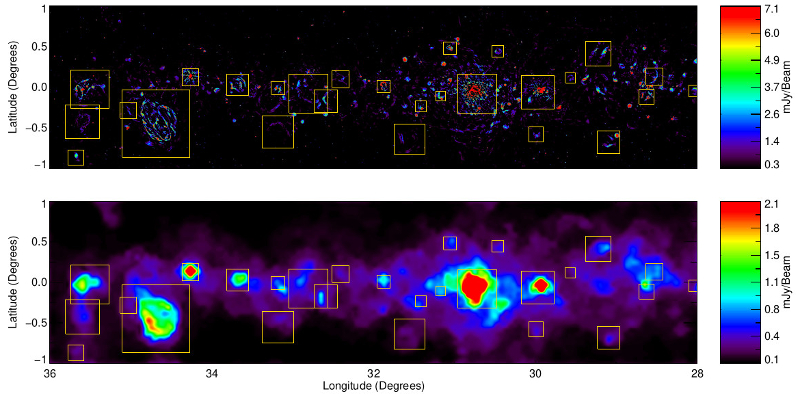| EPoS Contribution |
|
Early phases of high-mass star formation with the GLOSTAR survey
Sac Medina MPIfR, Bonn, DE | |
| One of the major challenges in modern astronomy is to understand the circumstances of high-mass star formation, in particular, its early stages, the massive Young Stellar Objects (YSOs). The galactic plane surveys aim to have more clues about them. In particular, the GLObal view of the STAR formation in the Milky Way (GLOSTAR) survey offers unique results because it is the most sensitive Galactic mid-plane survey at radio frequencies. GLOSTAR uses the wideband (4-8 GHz) C-band receivers of the VLA to conduct an unbiased survey to characterize star-forming regions in the Milky Way. I will present my work with GLOSTAR data (with 18" of spatial resolution at D-Configuration) focused on the detection of tell-tale tracers of early phases of high-mass star formation: compact, ultra-, and hyper-compact HII region among 28d < l < 36d, |b| < 1d. The characterization of the radio emission from around 1500 sources produced the first catalogue of the GLOSTAR survey, which includes the support of the emission nature for hundreds of sources previously undetected. I will discuss the flux values and physical characteristics of a statistically significant sample of YSOs and the important conclusions that influence in the galactic star formation, e.g., the HII regions are concentrated in the inner part of the Galactic mid-plane and the majority in the intersection of the galactic bar and the spiral arm. I will also discuss one of the most interesting results: the detection of 96 new HII region candidates. Finally, I will show some highlights about the preliminary results of the new GLOSTAR catalogue covering -2d < l < 28d, |b| = 1, and 36d < l < 56d, |b| = 1d. | |
 | |
| Caption: GLOSTAR mosaics and noise map of the present catalog. Upper panel: GLOSTAR radio continuum map at 5.8 GHz of 16 sq degrees of the Galactic plane (28d < l < 36d and |b| < 1d). Lower panel: full resolution noise background map determined by SExtractor using a mesh size of 80×80 pixels and threshold of 5 sigma. The yellow boxes correspond to the complexes that have been identified. | |
| Collaborators: J.S. Urquhart, UK, UK S.A. Dzib, MPIfR, DE A. Brunthaler, MPIfR, DE B. Cotton, NRAO, US K.M. Menten MPIfR, DE and the GLOSTAR team |
Key publication
Suggested Session: High-Mass Star Formation |

